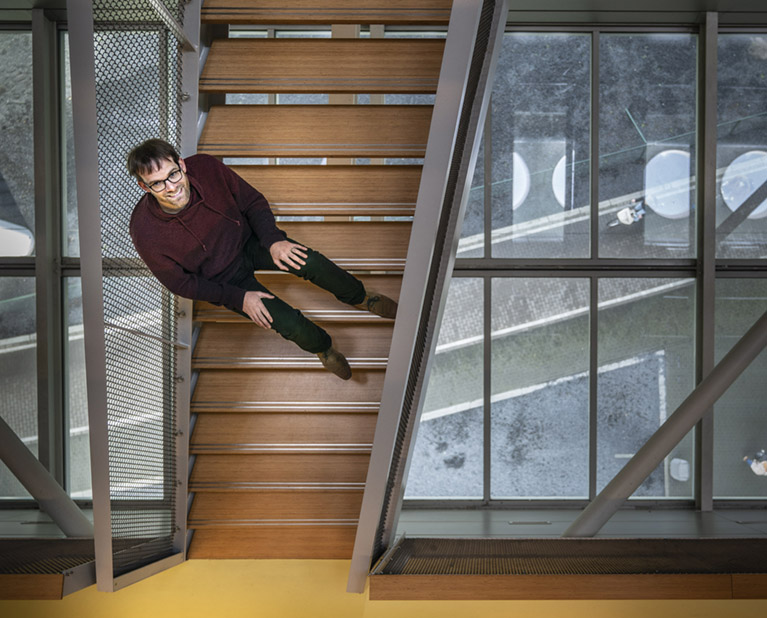
New vaccines are being made
Training T-cells to combat cancer
‘It’s a great time to be working on vaccines’, says Geert van den Bogaart. ‘Things wouldn’t have developed as quickly without Covid-19. The pandemic has led to quite a few new opportunities in the field. I’m happily making use of that.’
Since the pandemic, vaccines and immunity have become commonplace topics, says the professor of molecular immunology and microbiology. As the pandemic slowly fades into the background, the developments in his field are continuing. For instance, Pfizer and Moderna continue to develop the vaccines they made so quickly to be applied elsewhere. People are also working on innovative vaccination techniques that might help in the case of a new pandemic.
Cell proteins
One such innovation are peptide vaccines, which just so happen to be Van den Bogaart’s expertise. These ‘protein vaccines’ are based on the proteins on the surface of the cells in our bodies. ‘When you’re infected by a virus, so-called macrophages and dendritic cells eat the virus. The proteins from these pathogens are then expressed on their cell surface’, he explains. ‘They serve as a point of recognition for T cells, immune cells in our body, which fight the infection by killing the sick cells.’
The pandemic has led to quite a few new opportunities in the field
This system doesn’t just work for attacks from outside, but also when processes inside the body are disrupted. ‘Cancer cells also carry anomalous proteins on their surface’, says Van den Bogaart. ‘Cancer happens because of errors in the DNA. This not only causes cells to divide uncontrollably, but it also changes the proteins.’
Sometimes, our immune system notices those errors in the proteins, destroying the damaged cells. Other times, the infection or cancer cell goes undetected, which can cause a lot of damage. But peptide vaccines can be used to train the body. ‘They work just like any other vaccine: you inject small pieces of the protein into the body to teach the T cells to recognise the proteins. They’ll be able to respond more quickly to the next injection or anomaly.’
Less effective
Van den Bogaart isn’t the only person working on these new vaccines; all over the world, various kinds are being tested in clinical trials. Unfortunately, many of them turn out to be less effective in the human body than they were in the lab. That’s why no one’s succeeded in taking the next step to the application stage.
One of the biggest obstacles is the human body itself, says Van den Bogaart: ‘Our bodies are really good at breaking down proteins. The peptides usually get cleaned up before they can elicit an immune response.’
That means it’s important to properly protect the peptide. Researchers are using a little ball of fat that they put the molecules in. ‘It looks like the ball that mRNA vaccines use.’
The peptides usually get cleaned up before they can elicit an immune response
They also want to ensure that the immune cells reach their goals faster. ‘Current vaccines use what’s known as an adjuvant, a molecule that causes a small inflammatory response, activating the immune cells’, Van den Bogaart says. ‘We want to start developing that kind of system, too.’
He was awarded an ERC Consolidator Grant worth two million euros in 2019. Last month, he was given a Proof of Concept Grant worth 150,000 euros to make that last step. What’s interesting about his approach is that he adds another molecule in addition to the adjuvant. It impacts the dendritic cells that shows the immune cells the proteins. ‘This molecule makes the process more efficient and ensures the T cells recognise the protein.’
Within two years
Van den Bogaart won’t say what kind of molecules he uses for this process. ‘We’d eventually like to patent the technique, so I have to be a little mysterious.’ The idea is for there to be a working system within two years, which can then be tested through animal testing and clinical trials. ‘But that’ll probably take at least another fifteen years.’
Van den Bogaart thinks his system will be particularly useful to fight cancer. He doesn’t consider peptide vaccines competition for existing systems such as mRNA vaccines; more like an add-on. ‘mRNA systems were originally studied as cancer therapy but they turned out to be very effective against infectious diseases. We’ve been looking into the fields we think we can provide some added value. I think cancer treatment is one of them, because peptides are easier to manufacture than RNA and can be adapted more easily, too.’
Personalised protein vaccines would be absolutely amazing
The protein systems could ultimately even be personalised to suit individual cancer patients. ‘I can imagine that we might be able to isolate the DNA of tumour cells in the future, determine where the mutations take place, and use computer models to figure out which proteins were changed’, Van den Bogaart fantasises out loud.
These deviant proteins could then be incorporated in a vaccine, enabling a cancer patient’s body to recognise and attack the cells. ‘That would be absolutely amazing, but for now, it’s just science fiction.’
The professor will first continue to work on optimising peptide vaccines. Eventually, he hopes to prove that the systems can truly make a difference, but he’s happy that the world has become more open to innovative vaccine methods. ‘The way for mRNA vaccines has been cleared, which means there’s less resistance to these new techniques than there used to be. We have to jump on that.’